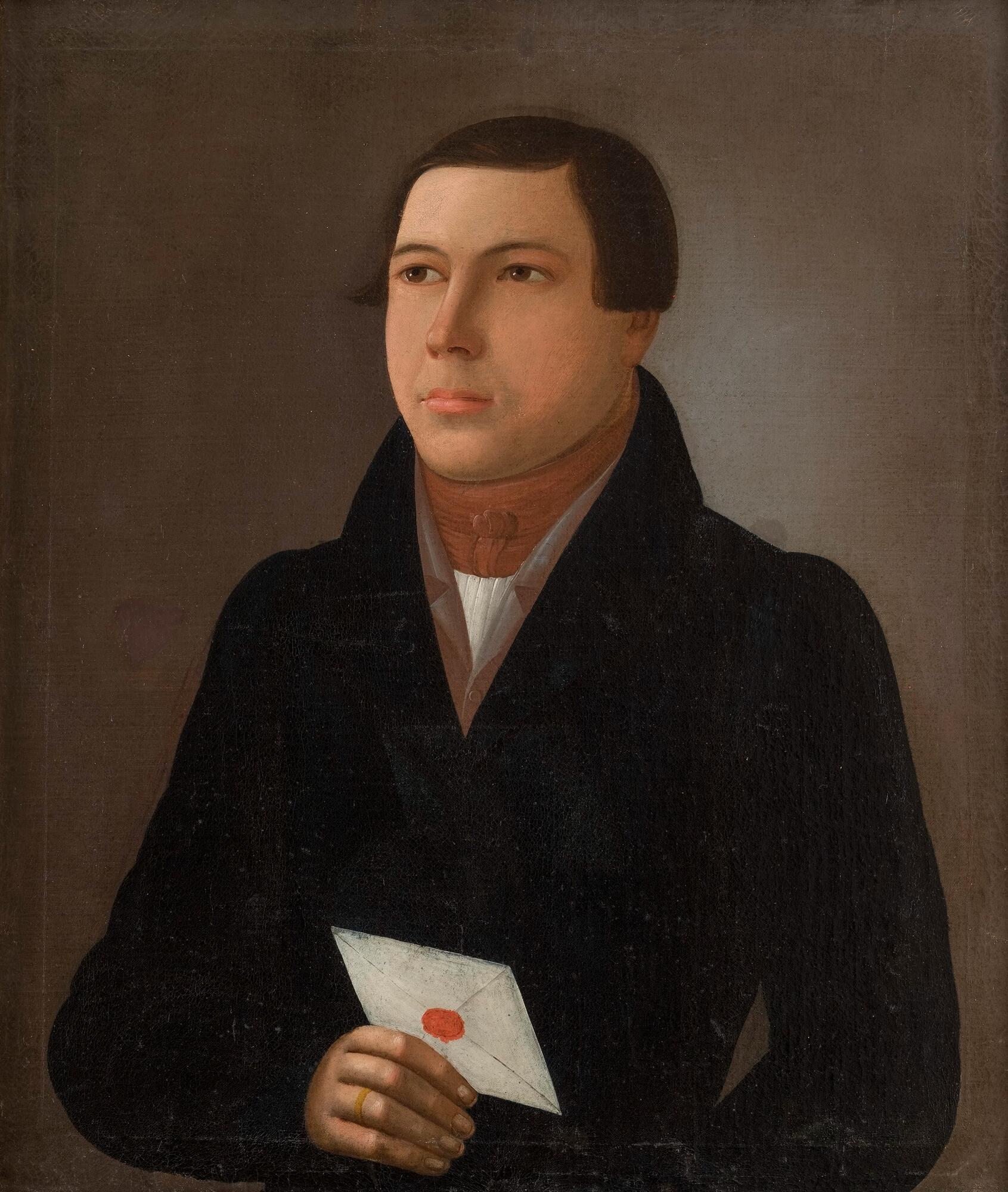The portrait of Vasily Suzdaltsev dates back to the 1830s — 1840s. The merchant is depicted at a young age. He is dressed after the fashion of the 19th century: he is wearing a fitted tailcoat with raised shoulders, a silk vest, and a white starched shirt under it. Suzdaltsev has a terracotta-colored scarf around his neck.
Vasily Suzdaltsev was a merchant of the first guild, an honorary citizen and a councilman of the town of Murom, that is, an elected member of the town council. His father, Stepan Suzdaltsev, was also a merchant. In 1865, his estates were the most expensive in Murom.
In the picture, Suzdaltsev is holding a letter, the envelope is sealed with a wax seal. The artist depicted a wedding ring on his ring finger. The merchant turned his head and body slightly to the right. This was usually the way men were depicted for paired family portraits that artists painted to order.
The picture was created in the genre of a merchant portrait, which appeared at the end of the 18th century. The heyday of the genre came in 1825 — 1850, when merchants, along with the nobility and the bourgeoisie, became one of the main social classes.
This genre was greatly influenced by Old Believer religious painting, as many merchants abided this faith. Masters sought to give the models a noble appearance: they were depicted with serious and calm faces, thoughtful or concentrated gaze and in natural poses.
Most often the merchants were painted chest-length or waist-length, as in the portrait displayed at the museum’s exhibition. The greatest attention was paid to the face and hands, while the interior was practically omitted. As a rule, a monochrome background was chosen for paintings so that unnecessary details did not distract viewers from the portrayed. In addition, such a picture was easier to fit into the environment of a merchant’s office, for which it was usually ordered.
At a young age, merchants were usually depicted without a beard. The artist painted Suzdaltsev with a clean-shaven face and a neat haircut. At a mature age, men belonging to the merchant class were depicted with a beard. For painters, it was important in the first place to convey the social status of the character. That is why male merchant portraits often had medals, jewelry or other attributes, a book for example. Artists also sought to create the right image: a respectable citizen, an exemplary family man, a successful businessman who leads a righteous life.
Vasily Suzdaltsev was a merchant of the first guild, an honorary citizen and a councilman of the town of Murom, that is, an elected member of the town council. His father, Stepan Suzdaltsev, was also a merchant. In 1865, his estates were the most expensive in Murom.
In the picture, Suzdaltsev is holding a letter, the envelope is sealed with a wax seal. The artist depicted a wedding ring on his ring finger. The merchant turned his head and body slightly to the right. This was usually the way men were depicted for paired family portraits that artists painted to order.
The picture was created in the genre of a merchant portrait, which appeared at the end of the 18th century. The heyday of the genre came in 1825 — 1850, when merchants, along with the nobility and the bourgeoisie, became one of the main social classes.
This genre was greatly influenced by Old Believer religious painting, as many merchants abided this faith. Masters sought to give the models a noble appearance: they were depicted with serious and calm faces, thoughtful or concentrated gaze and in natural poses.
Most often the merchants were painted chest-length or waist-length, as in the portrait displayed at the museum’s exhibition. The greatest attention was paid to the face and hands, while the interior was practically omitted. As a rule, a monochrome background was chosen for paintings so that unnecessary details did not distract viewers from the portrayed. In addition, such a picture was easier to fit into the environment of a merchant’s office, for which it was usually ordered.
At a young age, merchants were usually depicted without a beard. The artist painted Suzdaltsev with a clean-shaven face and a neat haircut. At a mature age, men belonging to the merchant class were depicted with a beard. For painters, it was important in the first place to convey the social status of the character. That is why male merchant portraits often had medals, jewelry or other attributes, a book for example. Artists also sought to create the right image: a respectable citizen, an exemplary family man, a successful businessman who leads a righteous life.



